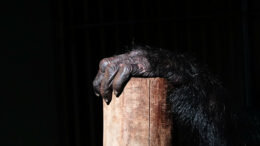Rachel the chimpanzee grew up in a suburban household under the care of an owner who treated her like a human child. She wore human clothes, ate human food, and took bubble baths. This went on until 1985 when, at the age of 3, Rachel’s owner felt she could no longer keep her animal instincts under control. Given up for adoption, Rachel eventually found herself at New York University’s Laboratory for Experimental Medicine and Surgery in Primates, where she stayed for more than 15 years.
She spent most of that time in a cage by herself — when doctors weren’t conducting medical tests on her, including 39 liver-punch biopsies.
According to government data, around 1,500 chimpanzees were used in biomedical research at any given time in the United States alone. Plans to abandon the controversial practice started in 2007, when the National Center for Research Resources announced it would stop funding breeding programs. The Great Ape Protection Act, which proposed to ban chimp testing altogether, made its way to Congress the following year, but it wasn’t until 2015 — after every other country in the world had already led the way — that this goal was finally achieved.
The reason chimpanzees were used in research then is the same reason they are no longer used today. While their humanlike DNA — 98.5% identical to ours — made them ideal guinea pigs for the study of medical problems and infectious diseases, their increased brain capacity also rendered them susceptible to sustaining complex and lasting psychological damage.
Although experts disagree on whether to call this post-traumatic stress disorder (PTSD), the majority of chimps emerged from labs with symptoms reminiscent of the condition, including hypervigilance, disassociation, and self-harm.
For years, caregivers and animal behaviorists at wildlife sanctuaries — which have taken on the “retired” medical animals — have worked to treat these symptoms, often to great success. At the same time, rehabilitation efforts remain riddled with unanswerable questions: How do chimpanzees experience traumatic events? Why do some individuals recover better or more quickly than others? Is it possible to apply human psychology to animals, even ones as closely related to us as chimps?
Diagnosing PTSD
Chimpanzee Jeannie arrived at LEMSIP when she was 22 years old. Records indicate that, like Rachel, she was originally kept as a human companion or pet. At LEMSIP she was subjected to a variety of invasive procedures, including vaginal washes, cervical and liver punches, and lymph node biopsies. She was infected with HIV, hepatitis NANB and hepatitis C. Following protocol, she was anesthetized by a dart gun before each procedure.
In total, Jeannie was “knocked down” more than 200 times.
Seven years into her time at LEMSIP, Jeannie had what researchers describe as a “nervous breakdown” that made further testing all but impossible. She suffered seizures and occasionally attacked her hands or feet as though they were not part of her own body. She arranged her food on the floor of her suspended cage instead of eating it. Whenever lab personnel approached her, she would scream, froth, salivate, urinate, defecate, roll back her eyes, and throw herself against all four sides of her confinement.
Rachel also became increasingly difficult to work with. A 2008 study of PTSD in chimpanzees said researchers would exercise extreme caution to avoid “angry outbursts, strenuous lunges, and attempts to grab or injure those who approached.”
Mostly, Rachel injured herself.
“When I met her in 1997, she was having dissociative episodes,” says primate communication scientist Mary Lee Jensvold. “She would attack her hands and hit herself in the head. All the things we talk about with trauma in people, that’s exactly what was going on with her.”
Great ape psychologist Gay Bradshaw, lead author of the 2008 study, made similar points. “Jeannie and Rachel lived under persistent environmental stress in an atmosphere of fear, unpredictability and nearly total lack of control over their world, with a perceived omnipresent threat of violence,” he wrote in the study. Bradshaw concluded their respective symptoms, even though they could only be observed externally, “were pathognomonic for dissociative and attachment disorders and for Complex PTSD.”
Restoring Agency
LEMSIP staff considered euthanizing Jeannie, and they would have put her down if the Fauna Foundation had not agreed to take her in instead. The Canadian wildlife sanctuary expected her to be a difficult chimp to work with, and they weren’t wrong. Jeannie was erratic and unpredictable, her mood switching between withdrawal and aggression on the turn of a dime. She was anorexic, asthmatic, immunocompromised, and uncoordinated, and her prescription medication was ineffective.
Sanctuaries working with traumatized chimps often use prescriptions as part of their treatment plan. Drugs like Depo-Provera, a contraceptive injection used in this case to regulate Jeannie’s blood levels, help with physical ailments. Selective serotonin reuptake inhibitors or SSRIS, which were given to Rachel, are used to treat both PTSD and other mental problems like depression or generalized anxiety disorder — two other conditions commonly observed in captive chimpanzees. In this, treatment plans for chimpanzees greatly resemble those of humans.
However, medication forms but one small part of a larger puzzle. Drawing from both psychiatric literature on PTSD in humans as well as the study of chimpanzees living in the wild, sanctuary employees have identified a number of shared strategies to help traumatized chimps recover. The goal, according to Kris Pritchard, caregiver at the Georgia-based Project Chimps, is to ensure “their abnormal behaviors aren’t so bad that it’s affecting their daily life.”
The first of these strategies revolves around building social connection: reintroducing chimpanzees who spent the better part of their life isolated in cages to interact with members of their own species.
“We’re social critters,” says Jensvold, referring to both great apes and humans. “Connection makes us feel safe. When we don’t, we engage in dysregulated behavior, like self-injury, which in extreme cases become catatonic.” It’s possible that, like humans, chimps engage in such compulsory behavior to alleviate negative emotions like anxiety, anger and sadness, though this claim is yet to be investigated thoroughly.
Because of their aggression, traumatized chimps at sanctuaries are typically introduced to the rest of the population while keeping them in separate compounds. Once they are released into the same space, they slowly engage in social behaviors such as grooming. This appears to have a positive impact on their mental health, with studies finding traumatized chimps who spent significant time at sanctuaries becoming “socially indistinguishable” from untraumatized ones.
The second strategy concerns space. Wild chimpanzees live a mobile, semi-nomadic lifestyle, patrolling territories that can span up to 115 square miles. Although no sanctuary has access to such a large amount of land, they provide their chimps with significantly more physical space than the average zoo. Project Chimps’ 236 acres of forested terrain, for instance, allows its residents to engage in other types of behavior observed in the wild, such as making nests, fashioning tools, and foraging for food.
The third and arguably most important strategy — closely connected to the first and second — is about agency.
“Social environments are healing,” says Jensvold. “But I would argue that the experience of captivity and losing agency is in and of itself traumatic. I mean, imagine spending your whole life inside of a cage and being aware of that.”
View this post on Instagram
Bradshaw notes that Jeannie and Rachel experienced a “total lack of control over their world,” making all their surroundings — even the safe ones — appear threatening.
Agency can be partially restored through enrichment, a now widely accepted practice which Bradshaw’s research helped popularize. Put simply, it involves peppering the sanctuary grounds with objects the chimps can use however they like, whether that’s trees to climb on, branches to collect termites, tires to play with, or — in the case of one ape living at Project Chimps — a piece of cloth they can choose to carry around with them like a flag.
Equally vital to restoring agency is giving chimps the freedom of movement. Or, in some cases, the freedom to not move.
“We have a female named Gracie who doesn’t go outside her habitat,” says Pritchard. “She just stays inside her villa, which has a covered outdoor area, even when her whole community is off somewhere. That’s something we allow her to do, though. She lived her whole life indoors, so the outside could be perceived as startling.”
While some abnormal behaviors subside over time, others persist. In some cases, sanctuary workers might make the decision not to push a certain chimp to alter the lifestyle they have become accustomed to, even if it is considered “unnatural.”
Slippery Slope
Treating traumatized chimpanzees presents various challenges, including basic communication. Although a few chimps understand and can communicate using basic American Sign Language, caregivers often have difficulty figuring out the meaning of other behaviors. Take, for example, a chimp who vocalizes and pulls at the bars of their enclosure when someone approaches. “It could be they have not seen that someone in a while and are upset,” says Pritchard. “Or it could be that they are excited to see them and want their attention.”
Then there’s the question of why some chimps seem to recover better or more quickly than others.
“I have heard of chimps biting themselves down on the bone,” says Jensvold. And yet, just as you can have “two soldiers experience a bomb blowing up and have only one come out of it with post-traumatic stress,” so too can you have two chimpanzees go through years of animal testing and arrive at sanctuaries with radically different dispositions and recovery rates.
Jensvold points to a chimpanzee named Sue Ellen. Like Rachel, Sue Ellen spent 15 years in research, where she was involved in procedures on a weekly basis. Unlike Rachel, however, Sue Ellen “emerged pretty stable, even though her experience was arguably much worse.”
Jeannie’s progress has been moderate. Although her seizures never went away, they now occur only once a month as opposed to daily, and while she never became actively involved in the community hierarchy, she did end up seeking out the company of other chimps.
Studies on the mental wellbeing of captive chimps are limited. Not just because the subject is complicated, but also because the scientific community has yet to give it the attention it deserves. Some say research into animal suffering is slowed by pressure from Big Pharma, which sees the subject as a slippery slope. If chimps can suffer from PTSD, who is to say monkeys — whose demand in the animal testing world soared after the outbreak of COVID-19 — can’t sustain enduring and profound psychological trauma as well?


